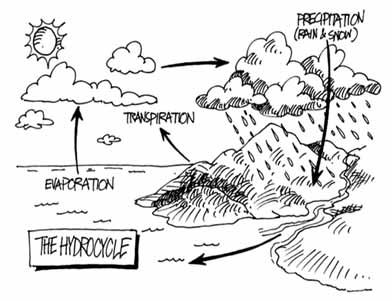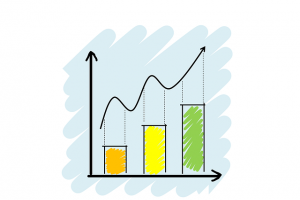Global Hydrological Processes and Role of Water Cycle in Hydro Balance

Global Hydrological Cycle Processes - The Hydro-Cycle
-
The hydrologic cycle describes the continuous re-circulating transport of the waters of the earth, linking atmosphere, land and oceans.
-
Water evaporates from the ocean surface, driven by energy from the Sun, and joins the atmosphere, moving inland as clouds. Once inland, atmospheric conditions act to condense and precipitate water onto the land surface, where, driven by gravitational forces, it returns to the ocean through river and streams.
-
The process is quite complex, containing many sub-cycles.
-
Engineering Hydrology takes a quantitative view of the hydrologic cycle.
-
The quantification of the hydrologic cycle which is an open system can be represented by a mass balance equation, where inputs minus outputs are equal to the change in storage.
-
It is a basic Hydrologic Principle or equation that may be applied either on global or regional scale
I - O = ΔS
The water holding elements of the hydrological cycle are :
:
- Atmosphere
- Vegetation
- Snow packs
- Land surface
- Soil
- Streams, lakes and rivers
- Aquifers
- Oceans
Hydrological Cycle also known as Water Cycle is the study of continuous movement of water on, above and below the earth surface.
The main processes involved in hydrological cycle are:
- Evaporation
- Condensation
- Precipitation
- Interception
- Infiltration
- Percolation
- Transpiration
- Runoff
- Storage
The water cycle begins with the evaporation of water from oceans and other water bodies. The resulting vapors are transported by moving air and under proper conditions, the vapor are condensed to form clouds, which in turn results in precipitation.
The precipitation which falls upon land is dispersed in several ways. The greater part is temporarily retained in the soil near where it falls and is ultimately returned to the atmosphere by evaporation and transpiration by plants. A portion of the water flows over surface soil to stream channels, while other penetrates into the ground to become part of the ground water. Under the influence of gravity, both surface and underground water move towards lower elevations and may eventually discharge into the oceans.
This Hydrologic Cycle recycles the earth’s valuable water supply. In other words, the water keeps getting reused over and over.



